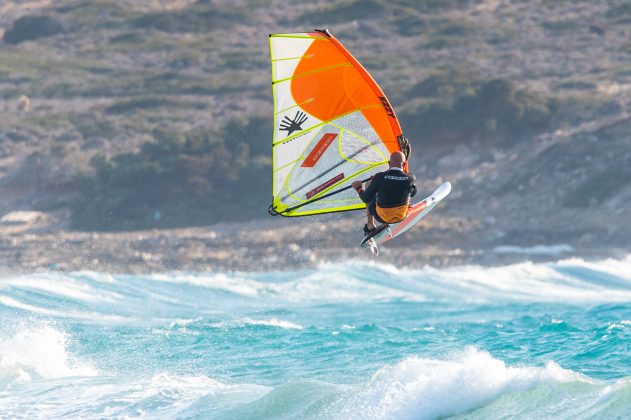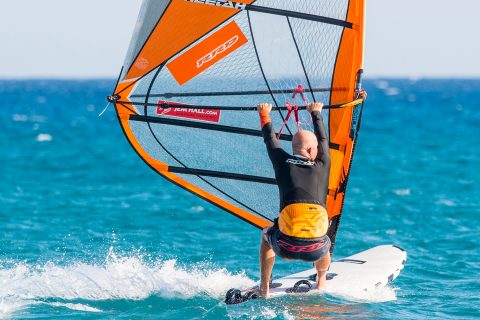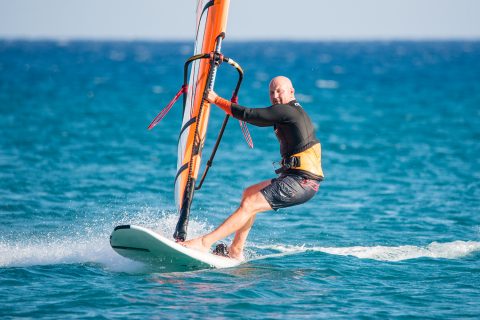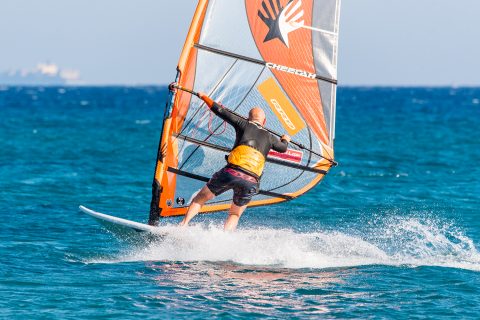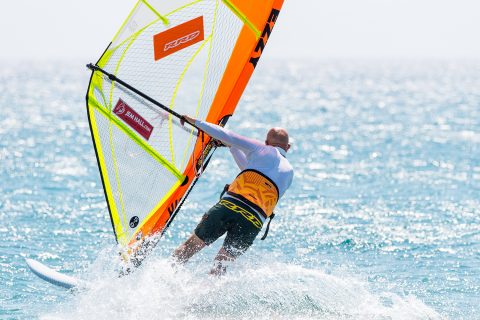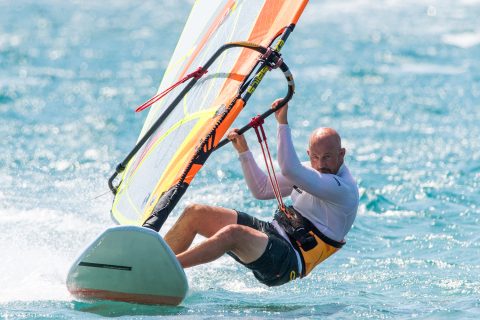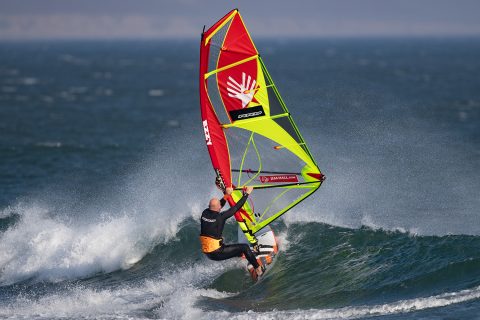JEM HALL
MOVE ON UP – WINDSURFING TECHNIQUE
ALL IN THE HIPS
From our May 2021 issue of Windsurf Magazine, our technique guru Jem Hall explains how the position of your hips can help improve your windsurfing.
PHOTOS – Clark Merritt, Eye Sea You Photo
Stance
Let’s look at the key position our hips should be in:
- Brilliant basics: the hips raised position, with shoulders out, is where all our good habits start. We rarely want our shoulders inboard of our hips.
- Lock out in lulls: look to get your hips raised and arms extended as you hit a lull. The hips can also subtly swing and lean forward. Try to spot lulls early and anticipate the drop in power.
- Get down in gusts: again try to see the gusts and drop your hips lower to control the power, as from here we can pull down on the boom more. Our rear hip should also be moving down, back and out to keep the sail sheeted in.
- Feel the power to plane: early planing and stance is an article in itself, so here I will just remind you that there is a time to raise your hips and tip the rig forward to get planing when you have less power. And there is also a time to get as low as possible to pull down on the boom and push the board downwind when you have plenty of power.
- Dropping our hips helps us to pull down on the boom to get planing.
Having fluid hips is so much easier to achieve in our stance if we are sailing on (relatively) long lines. These longer lines means you are not, in effect, hooking into the boom as you might as well be with short lines. The longer lines will also aid unhooking and keeping our hips out on the way into moves.
Tacks
- The hips start out and then shift forward as we go through our tack, aided by looking forward in the entrance phase.
All moves require our hips to be in the right place, but for the tack it is perhaps of the utmost importance.
- Getting ready: the hips need to be committing and balancing the sail’s power as we begin to move our hands, and then feet, in readiness to start the tack.
- Weight shifting: as we begin to turn into the wind, the hips move forwards and out, as the rig moves back, all aided by looking forward. This helps get the weight off the back foot so it can move.
- Getting out: the transition of the footwork should be fast and precise – go for it and send the rig as far and as fast forward as possible so your hips can go back and be ready to control power and to assist your legs in steering out of the move and back across the wind.
- Shifting the hips across readies us for the foot change, which is ably assisted by seeing the clew with our back hand well back.
Carve Gybes
- Getting ready: the hips need to be committing and balancing the sail’s power as we move our hand back and then unhook. Keeping them down and out aids unhooking and keeps speed, so we can take this into the gybe and gives us time to get our back foot out and steer downwind.
- Getting forward: feeling and understanding the sensation of carving is all about going forwards with the rig, so whilst the hips are out they then have to go forward over the board so we can be in a position to carve the board and feel the rail.
- Getting across: this key position is where a lot of gybes can and often fail. After the carve phase we have to open the sail and send the hips across. Back hand far down the boom helps this as it will open the sail faster and it will help you put the sail to the outside so the hips can go to the inside. And yes, seeing the clew here helps us send our hips. All of this helps the foot change and puts you in a strong position at the exit.
- Getting out: if our hips are across, to the inside of the turn mid gybe, then they are well placed to take some power clew first, and furthermore be able to carve ‘out’ on our heels.
- Rig moving out of the turn as hips go across to the inside really helps for the duck gybe.
Hands down the best way you can boost your gybes is to be outboard (hips low) after unhooking and then really getting your hips to the inside mid gybe. This will not only aid your gybes, but also assist in gaining smoother rail-to-rail wave riding, how we gybe is, after all, how we ride.
- Really dropping your hips down and out will help you sheet the sail in and keep the board flat when well powered.
Jumps
This is a move where I have found people often underappreciate just how much, and how subtly, our hips move.
- Getting ready: a key part of getting airborne is being able the push the tail down, to send the nose up, so we have to shift from being outboard and sailing into being inboard and ready to pop. Subtle but oh so important and why I implore people to learn to pop on flat water as it is here where we learn to really get the nose up and out.
- Getting flight: our hips are over the board to pop, but they must move outboard in the air. This will turn the rig into a glider and also help us lift the rail to get the wind under the board. This tucked position is not only good technique, but also makes the whole move safer!
- Getting down and out: as we come in to land we should sheet out and come over the board so we don’t give the tail a massive push downwind on landing. It will also place us where best to be for getting some speed up after touchdown.
If you are already jumping, try to get some longer jumps and move on to some tail and rail grabs, as these will all shift your arse and hips outboard in mid air.
- Hips moving across and back helps us carve back up the wave
Wave riding
There are strong parallels between gybing and wave riding. Focus on some of the key positions in your gybes on flat water in medium to strong winds and you are boosting your skills in wave riding. The missing link in wave riding is getting our hips across mid turn so we can carve the board back up the wave. Carving into more tacks will also help us boost our top turn carving skills. Some key points are:
- Getting in: this means getting the rail in and to do this we have to get the rig forward and our hips going forward, even if we quickly move to back foot carving for a more onshore or tighter turn.
- Getting it up: open the sail, see the lip of the wave and send the hips not only across, but back, so we can carve off the back foot to get the board turning back up the wave. Your hips can move a long way back if you are low and your arms are extended for even more effect.
- Getting across: this is the most fluid and more challenging part of riding. As you start, move your hips back over the board and heading towards being outboard, so we can change the board’s direction and then carve out of the turn. Looking forward and towards the beach really helps this process as does moving your back hand forward.
- Getting spray: if we move our hips outboard, like we want to wash our arse in the sea, then we are in a position to bank and carve the board and yes throw up some spray.
A last point for rides is that if your hands are well placed for gybes, then they are automatically well placed for rides. I really feel much more comfortable gybing and bottom turning with my back hand back and yet I still work to get it further back.
RRD boards, wetsuits & softwear, Ezzy sails & Black Project fins sponsor Jem Hall. Get him live and direct on one of his highly acclaimed coaching holidays – check out www.jemhall.com for more details. You can also follow him on twitter / Facebook / Instagram.


